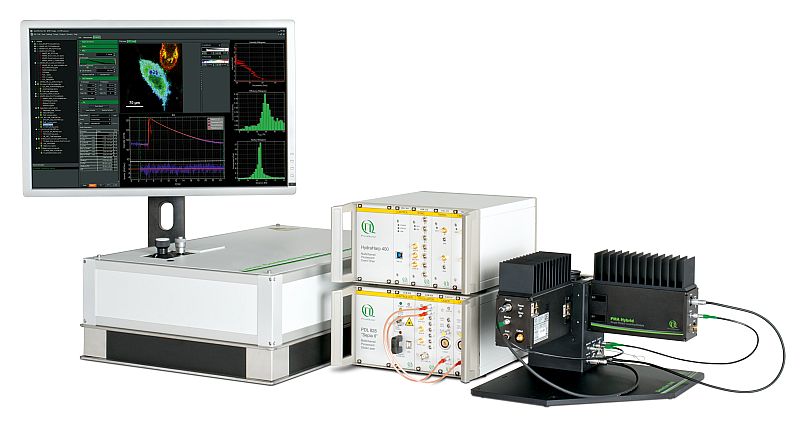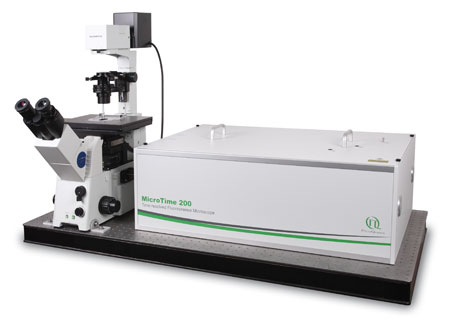 A Two-Photon Excitation (TPE) set-up is, in principle, not very different from a confocal fluorescence set-up. A collimated beam is focused by an objective, and the fluorescence is collected by the same objective and and passed on to the detection unit. Depending on the realization, scanning can be performed by sample- or objective scanning (MicroTime 200), or laser scanning (LSM Upgrade Kit). For laser scanning, descannend as well as non-descanned detection are possible. In the latter case, no pinhole is used.
A Two-Photon Excitation (TPE) set-up is, in principle, not very different from a confocal fluorescence set-up. A collimated beam is focused by an objective, and the fluorescence is collected by the same objective and and passed on to the detection unit. Depending on the realization, scanning can be performed by sample- or objective scanning (MicroTime 200), or laser scanning (LSM Upgrade Kit). For laser scanning, descannend as well as non-descanned detection are possible. In the latter case, no pinhole is used.
Consequently the essential components of a time-resolved TPE set-up are:
- Femtosecond pulsed laser source
- Single photon sensitive detector
- Dichroic mirror (to separate fluorescence signal from excitation light)
- Objective (to focus the excitation light into the sample and collect fluorescence signal)
- Scanning device
- TCSPC unit to measure the time between excitation and fluorescence emission
Related technical and application notes:
The following PicoQuant systems can be equipped to carry out two-photon experiments
 MicroTime 200
MicroTime 200
Modular, time-resolved confocal fluorescence microscopy platform
The MicroTime 200 time-resolved fluorescence microscope system is a powerful instrument capable of Fluorecence Corelation Spectroscopy and its daughter techniques as well as Fluorescence Lifetime Imaging (FLIM) with single molecule detection sensitivity. It contains the complete optics and electronics for recording virtually all aspects of the fluorescence dynamics of microscopic samples or femtoliter volumes. The instrument gains its exceptional sensitivity and flexibility in combination with unprecedented ease-of-use from a unique fusion of miniaturized and highly sophisticated state-of-the-art technologies. Although, these technologies enable to run an instrument of comparable complexity and power without having to spend more time on instrument maintenance than on original scientific content, the MicroTime200 remains an open platform that allows the advanced scientist to easily built upon the open character of the instrument in order to realize highly customized applications
 LSM Upgrade Kit
LSM Upgrade Kit
LSM Upgrade Kits from PicoQuant add time-resolved capabilities to laser scanning microscopes from many major manufactures
Confocal Laser Scanning Microscopes (LSMs) are widely used tools in cell and molecular biology, biochemistry and other related sciences. PicoQuant's LSM Upgrade Kits greatly enhance the capabilities of these microscopes by extension to time-resolved techniques, and thereby providing not only Fluorescence Lifetime Imaging (FLIM) but also Fluorescence Correlation Spectroscopy (FCS) and a wealth of other time resolved techniques. The LSM Upgrade Kit combines PicoQuant products to a ready-to-use kit that fits your specific application on a state of the art Laser Scanning Microscope of your choice from Leica, Nikon, Olympus or Zeiss.
The following core components are needed to build a system capable of FLIM measurements, which are (partly) available from PicoQuant:
- Laser
- High power femtosecond pulsed infrared laser
- Two-photon beam conditioning for the MicroTime 200
- Photon counting detector
- TCSPC electronics
- Analysis software
- Scanning device
- Confocal optics



 Contact us
Contact us
 MicroTime 200
MicroTime 200 LSM Upgrade Kit
LSM Upgrade Kit



